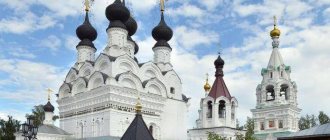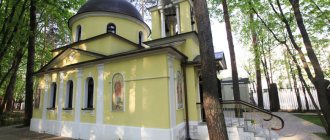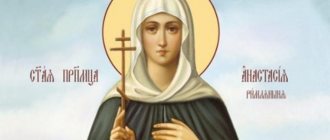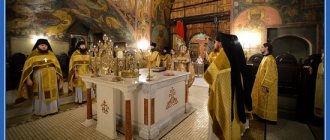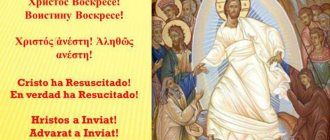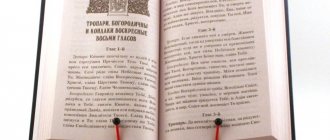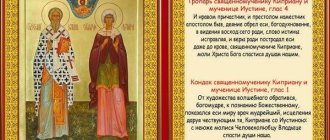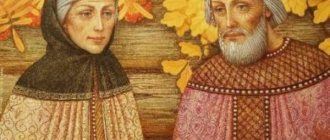Troparion from the Greek word means melody, tune.
Troparion is one of the church hymns that is performed at the Divine Liturgy. The troparion indicates the essence of a church holiday or glorification of saints.
Troparion
in Greek means melody or tune
There are different chants for different occasions in life. Troparions are sung daily at morning and evening liturgy
Previously, troparia were written in prose, and were intended to commemorate the holy martyrs who were glorified on one day or another
Nowadays, troparia have become paired chants that worshipers sing in chorus during worship. If anyone does not know the troparion of the holiday, then stand and listen.
During the service there are troparia intended for each day of the week.
- Monday. On this day, the memory of all heavenly ethereal ranks is honored. On this day, praying people turn to the heavenly archangels with glorification.
- Tuesday. Believers glorify the memory of John the Baptist and other holy prophets.
- Wednesday and Friday. Believers remember the Savior's feat and his tragic death. All hymns of these days are dedicated to the Life-Giving Cross. Thursday is the day of veneration of all the holy apostles, as well as St. Nicholas the Wonderworker.
- Saturday. It is customary to read the funeral rites and remember all the holy martyrs.
In each church on patronal feast days one troparion and one kontakion are performed.
For each service there is an order in which the chants are sung. First, all the troparia are sung, then all the corresponding kontakia are sung in the same sequence.
Troparia, kontakion and hymns to all saints are sung on Saturday
Now we will talk about the troparion to all the saints. The Feast of All Saints is celebrated a week after Trinity.
All Saints' Day is celebrated on the same day as the celebration of the Icon of All Saints. Let's see how this troparion for the feast of all saints sounds.
Troparion to all saints
Troparion, tone 4:
God our Father, deal with us according to Your meekness, do not leave Your mercy from us, but guide our lives in peace with their prayers. Apostles, martyrs and prophets, saints, saints and righteous ones, who have accomplished good deeds and kept the faith, who have boldness towards the Savior, for us He is good, pray, pray, save to our souls.
What does Introparion mean? Introparion means another troparion. This suggests that not one troparion was written for this holiday, but two.
Troparion
means “another troparion,” which means that two troparions were written for the Feast of All Saints
Troparion to the Cathedral of All Saints, voice:
And throughout the whole world Thy martyr, as Thy Church was adorned with scarlet and visor, with blood, with these we cry unto Thee, O Christ God: unto Thy people Thy bounties have come down, O world of life. Grant to Your body and to our souls great mercy.
Kontakion, tone 8:
As the firstfruits of nature are brought to the Planter of creation by Ti, Lord, God-bearing martyrs; With those prayers in the deep world Thy Church, Thy residence of the Mother of God, O Most Merciful One, has been preserved.
Also, at every holiday, greatness is sung. Greatness is another word for praise, the glorification of someone, for example a saint. Here too we can see that there is glorification of all the saints.
Magnification:
We magnify you, apostles, martyrs, prophets and all saints, and we honor your holy memory, for you pray for us to Christ our God.
Troparion of the Venerable Martyr Fevronia (general troparion to the martyr). Voice 4
Your Lamb, Jesus, Fevronia/ calls with a great voice:/ I love You, my Bridegroom,/ and, seeking You, I suffer,/ and I am crucified, and I am buried in Your baptism,/ and I suffer for Your sake,/ for I reign in You,/ and I die for You, and I also live with You;/ but as an immaculate sacrifice, accept me,/ sacrificed to You with love.// By your prayers, for You are merciful, save our souls.
REVEREND DALMAT OF ISETK
Commemorated on June 25 / July 8, July 24 / August 6 (Discovery of Relics), February 5 / 18 (Greek [202]) and in the Cathedral of Siberian Saints
In the world Mokrinsky Dmitry Ivanovich, born in 1594 in Berezovo (now the village of Berezovo, Khanty-
Mansi Autonomous Okrug)
| St. Dalmat. Portrait. XVIII century (?). Photo by S. M. Prokudin-Gorsky. 1912 (Library of Congress) |
The biography of the monk is set out in “News of the Founding of the Dalmatov Monastery”
, written at the beginning of the 18th century by his son, Archimandrite Isaac (Mokrinsky). A large amount of information is contained in documents of Siberian records management of the 17th century and in the archives of the Dalmatovsky Assumption Monastery[203].
Ivan Mokrinsky, the saint’s father, served as a Cossack ataman in Siberian cities; his mother may have come from newly baptized Siberian Tatars or Ostyaks[204]. Dmitry Mokrinsky was turned into a boyar's child. Around 1627/1628, the Mokrinsky family was transferred from Berezov to Tobolsk.
In 1628, Dmitry Mokrinsky was mentioned as the mayor of Tobolsk; in 1633, he held the position of clerk[205] in the Vagai prison. He was married and had children. But after the death of his wife (+ 1642/1643) he left the sovereign's service and took monastic vows with the name Dalmat in the Nevyansk Epiphany Monastery.
Around 1644, seeking solitude, Dalmat left the monastery (Archimandrite Isaac (Mokrinsky) wrote that he did not want to accept the position of builder at the Epiphany Monastery offered to him) and settled in a cave on the high bank of the river. Iset at the confluence of the river. Techa, called White Settlement. These lands belonged to the Tyumen yasak Tatar Iligey, who leased them to residents of the Nevyansk and Irbit settlements for fishing and animal industries. The owner of the land, under the influence of the tenants, twice tried to expel Dalmat. First a saint «…
Seeing him rage like this and thinking humanly, remembering the Apostle Paul: “In Rome she was called to the Romans,” and so on, and Elder Dalmatus also fell in love with him, a Tatar, born after his sister: “And my mother was born of the Siberian Tatars, having been newly baptized.”
And then hearing this Iligey Tatar and Abiye Presta for a short time from the murder .”
The second time the saint was saved by a miracle: in the fall of 1645, Iligei, who was heading to the elder’s cave to drive him out, spent the night on the road and had a vision: the Mother of God in crimson robes with a whip in her hand commanded not only not to offend Dalmat, but also to give him the patrimony. The Tatar was seized with horror, and in the presence of his children and relatives in the spring of 1646, he transferred the possessions of the White Settlement to the monk. In 1651, the monks of the Dalmatov Monastery turned to Tsar Alexei Mikhailovich and the Tobolsk governor V.B. Sheremetev with a petition for the granting of these lands to them; the tsar’s charter dated May 17/30, 1659 established the boundaries of the monastery possessions.
After some time, the brethren gathered around the desert dweller and the Iset Hermitage arose; in the second half of the 1640s, a wooden chapel and cells were built in it. From the Nevyansk Monastery the monk brought with him the Dalmatian Icon of the Dormition of the Blessed Virgin Mary, which became the main shrine of the Dalmatov Monastery (lost in the 1920s). The newly founded monastery was the first Russian settlement in the river valley. Iseti. Subsequently, the Dalmatov Assumption Monastery played an important role in the education and economic development of the region; for a century it was an outpost in the defense of the eastern borders of Russia from the raids of Kalmyks, Bashkirs and Siberian Tatars.
In addition to the spiritual care of monks and laity, Dalmat devoted a lot of energy to the economic life of the monastery under construction. In the sparsely populated region, the problem of labor was acute. In search of peasants to work in the monastery estates, Dalmat traveled through the settlements of the Tobolsk and Turin districts, often came into conflict with the local secular administration, and sometimes violated the royal prohibitions regarding the admission of new peasants. Thus, in 1654, the clerk of the Kirginskaya Sloboda, M. Fefilov, submitted a petition to the Tobolsk governors that Dalmat refused to hand over the fugitive arable peasants of the Kirginskaya Sloboda who had taken refuge in the Dalmatov Monastery. The governors sent a memorial to the monastery so that “the peasants would not be accepted for taxes”[206].
In September 1651, returning from another trip, Dalmat found the site of the monastery in ashes. The chapel, cells and peasant households were burned by the army of the Siberian prince Devlet-Girey. Miraculously, the icon of the Assumption of the Blessed Virgin Mary survived the fire. And the companions gathered again, the monastery was revived.
In 1662 - 1664, the monastery was again subjected to devastating attacks by Bashkir nomadic tribes and the grandchildren of the last Siberian Khan Kuchum. But after each devastation, the monastery was rebuilt again. Elder Dalmat survived difficult times of disasters and trials. Several times he was close to death, twice before his eyes the monastery was destroyed to the ground, and twice he again erected it from a pile of ashes and ruins. A church was built in honor of the Assumption with a chapel in the name of St. Demetrius of Prilutsky, cells and monastic services, the monastery was surrounded by a prison, and a church in the name of the apostle was consecrated above the holy gates in 1683. John the Theologian.
In the restored monastery, a cell was built for the saint, where he spent the rest of his life in seclusion.
Dalmat, who in his humility did not seek vain glory and power, until his death remained only a simple old monk, despite the fact that he, as the founder, organizer and leader of the monastery, rightfully belonged to the abbot of it. But although other elders officially ruled the monastery, Dalmatian authority was great, and his word was decisive. He was always a supporter of strict adherence to the canons, and no circumstances could force him to deviate from them. In the same spirit he instructed the monastery brethren. Thus, in 1664, the Tobolsk Congress House conducted an investigation into a denunciation of one of the elders against the monastery administration. Among other offenses, it was noted that the days of the angel Tsar Alexei Mikhailovich and members of his family were not celebrated in the Dalmatovsky Monastery. As Dalmat explained “in the cap behind his hand,” from the beginning of the existence of the monastery, such an order was established: if the days of the angel of the king and queen fell during Lent or fasting days, then only a prayer service was performed in the monastery for their spiritual salvation and long-term health, and the celebration took place after Bright Week. At the same time, Elder Dalmat emphasized that this was done at his command, and without his command. «
the brethren, according to their own wills, to this day have not begun or done any spiritual or physical work
”
[207] . Thus, even under pressure, the founder of the monastery did not deviate from the charter. From the same case it is known that, on the instructions of Dalmat, armed patrols were sent “to the steppe to hear news” about the approach of nomads. With all this, at that time the elder was already living in seclusion, so he could not even be taken to Tobolsk to examine the “sovereign’s deeds and words” in 1664.
After 1651, Isaac (Mokrinsky), the son of Dalmat, took monastic vows at the monastery, becoming the first abbot of the monastery in 1666 and archimandrite in 1702. Not only blood, but also spiritual kinship connected father and son. In the entry on the book of St. John Chrysostom “On the Priesthood” (M., 1664), blessed by the Patriarch of Moscow and All Russia Joachim to Abbot Isaac in 1682, the latter is called a disciple of Dalmatus[208]. Also, the first Kholmogory and Vazhsky Archbishop Afanasy (Lyubimov), who settled in the Iset desert in the early 1650s and lived there for more than 10 years, considered himself a disciple of Dalmat.
| St. Dalmat Isetsky |
The Dalmatov Monastery did not immediately accept the liturgical reforms of Patriarch Nikon. The former abbot of the Nevyansk Epiphany Monastery, Eusebius (Levonov), who was tonsured at the Dalmatian monastery, wrote in a denunciation after 1724 that Dalmatian and his son belonged to the schism.[209] There is a hypothesis that the ideologists of the Trans-Ural Old Believers appealed to Dalmat’s opinion in polemics about the essence of the Antichrist.
At the beginning of the 20th century, the library of the Dalmatovo Monastery contained 2 books that belonged to the monk:
- "Conversations on the Acts of the Apostles" by St. John Chrysostom (K., 1624) with “Interpretation of the Apocalypse” by Andrew of Caesarea (K., 1625) (in one binding)
- "Conversations on the Epistles of the Apostle Paul" by St. John Chrysostom (K., 1623). On March 23, 1679, it was invested by the monk in the Church of St. Nicholas the Wonderworker on the monastery grounds.
The monk died on June 25/July 8, 1697 in the Dalmatovsky Monastery. While still alive, he prepared himself a coffin-deck. He was buried in the altar of the Assumption Church of the monastery.
In 1720, the construction of the new, three-altar Assumption Cathedral was completed. On the site of the old Assumption Church, a cobblestone tomb was built over the burial place of Dalmata. The central place in it was occupied by a wooden tombstone, painted in 1793 by the artist I. Sokolovsky with scenes from the life of the saint. The tomb contained relics that, according to legend, belonged to Dalmatus - a helmet and chain mail donated by Iligei (currently in the Sverdlovsk Regional Museum of Local Lore), as well as a schematic robe.
In 1836, provincial secretary P. D. Ponomarev decided to build a church over Dalmat’s grave at his own expense. In 1845, the peasant M. F. Zaitsev applied to the Perm Consistory for permission to build a chapel in the city of Dalmatovo on the site “marked by the asceticism of the monk Dalmat.” Both projects did not receive the approval of the spiritual authorities.
In 1871, near the burial of Dalmata, construction began on a church in honor of the icon of the Mother of God “Joy of All Who Sorrow.” While laying a trench under the foundation, the builders found the saint’s coffin. Eyewitnesses testified that the coffin, despite the age of burial, was in amazing preservation. But the discovery of the relics of the saint, according to the instructions of the church authorities, did not happen then. After lengthy correspondence between the rector of the monastery, Archimandrite Isaac, and the ruling and vicar bishops and the examination of the coffin and crypt by Bishop Vassian (Chudnovsky) of Yekaterinburg, it was decided to leave Dalmata’s coffin (without opening it) in the same place and change the configuration of the foundation. While the monastery was looking for a solution to how to fulfill this order, heavy rain broke out over Dalmatovo. Water filled the ditches, its level was higher than the crypt. But the monks believed that the coffin was reliably protected and, having removed the water from the ditch, did not show concern. However, during confession, two women told their confessor that they had a vision of water gushing out of Dalmata’s coffin. Impressed by what they heard, the archimandrite and the hieromonk secretly dug up the ground, dismantled the protruding part of the crypt and discovered that water had entered the coffin and left its traces - excessive dampness and a large sediment of sand and silt. As the opening of the crypt in 1994 showed, the ingress of water had a strong destructive effect on the relics of Dalmatia.
On May 8/21, 1881, the consecration of the temple took place, which had chapels in the name of St. Stephen of Great Perm and in the name of Saints Isaac, Dalmatus and Favst. In 1896, a stone tomb was added to the temple, located directly above the burial. From the inside, its walls were decorated with picturesque images of episodes from the life of the monk; on the northern wall there were portraits of Dalmatus and Archimandrite Isaac.
After the closure of the monastery in 1923 and the cessation of services in the Church of Sorrows in 1928, since 1933 the tomb has successively housed the wardrobe of the state farm theater, a hospital, production premises of the Start dairy engineering plant, and a laundry. The internal appearance of the tomb has changed beyond recognition. St. Dalmat's belongings were transferred to the local history museum. The wooden tombstone, richly decorated with paintings, ended up in a landfill. The floor was repeatedly concreted, the paintings on the walls were painted over.
In 1991, the monastery complex was returned to the Church, and the difficult work of reviving the monastery began.
Reverence
| Chain mail and helmet of St. Dalmata. Ser.—2nd half. XVII century (?). Photo by S. M. Prokudin-Gorsky. 1912 (Library of Congress) |
There is no documentary evidence of the canonization of St. Dalmat. However, in a report to Bishop Anthony of Perm and Verkhoturye in 1871, in one case Dalmat was simply called a monk, in the second - a reverend.
In 1864, at the request of the inhabitants of Dalmatia, “burdened by disasters from fires,” an annual religious procession was established “to avert disasters” on June 24 / July 7, the day of the death of Dalmatia (date inaccurate).
Since 1871, records of miracles through prayers to the saint were kept in the Dalmatovsky Monastery; about 30 such records from the 19th century have been preserved in the monastery archive. In the Urals, the monk was considered the patron saint of warriors - young people, before being sent to the army, came to the tomb of the monk, put on chain mail and a helmet.
In the 2nd half of the 19th century, in periodicals, in official documents, and in lithographic images (in particular, those published in Yekaterinburg in the 90s), Dalmatus was often called the venerable. He is commemorated in the service to all saints who have shone in the Russian land, compiled in 1918 by Bishop Afanasy (Sakharov).
In 1994, in the year of the 400th anniversary of the birth of the Monk Dalmat and the 350th anniversary of the founding of the monastery and the city named after the monastery by Dalmatov, it was decided to conduct archaeological excavations of the elder’s burial, pay due honors and rediscover the main shrine of the monastery. On August 6, 1994, the discovery of the relics of the Monk Dalmatus took place, which have since rested openly in a carved wooden shrine in the Sorrowful Church of the monastery.
In 1997, on the 300th anniversary of the repose of St. Dalmatus, a service and akathist to him were written.
In 2004, Patriarch of Moscow and All Rus' Alexy II blessed to canonize the founder of the Holy Dormition Monastery, Dalmat of Isetsky, among the locally revered saints of the Kurgan diocese and to include the name of the Venerable Dalmatian of Isetsky in the Cathedral of Siberian Saints with the establishment of a day of remembrance on June 25/July 8[210].
On February 4, 2013, the Council of Bishops of the Russian Orthodox Church approved the church-wide glorification of St. Dalmatian of Isetsky.
The Monk Dalmatus is widely revered in the Urals. The Dalmatovsky Monastery keeps records of the testimonies of pilgrims and local residents about grace-filled help and healing through prayers to the Monk Dalmat.
A series of documentary films has been created about the Venerable Dalmatian of Iset, in particular, by the Creative Association “White Settlement” operating at the Dalmatovsky Monastery (films: “The Land of Siberia, an incomparable intercessor”, “Elder Dalmatian. A short biography”, “From the earthly army to the heavenly army”, “ Akathist to the Venerable Dalmatian of Iset, miracle worker").
In May 2012, a medal of the Kurgan and Shadrinsk diocese was established in honor of the Holy Venerable Dalmatian of Isetsky of two degrees[211]
Iconography
To date, a rich iconographic tradition of depicting St. Dalmatian of Iset has developed.
The earliest image of Dalmatus was obviously his portrait, which was on the northern wall in the saint’s tomb along with the portrait of his son Archimandrite Isaac[212]. According to G.S. Plotnikov, both images were lifetime: “...two portraits painted from life are kept; one of the monk Dalmat, with whom is his cell robe and hood, and the other of his son Archimandrite Isaac, with whom is his staff...”[213].
Judging by the transparencies, the portraits were presumably made in the 18th century (possibly among 8 painted portraits commissioned by Archimandrite Joaquinthos in the 60-70s of the 18th century by the Tobolsk icon painter Matvey Morozov[214]), and were subsequently updated.
Dalmatian is depicted half-turned to the right, waist-deep, dressed in a hood and mantle, his right hand with a rosary at his chest, a high staff in his left, and a lengthy text with his biography below. The individual features of the old man’s face are conveyed conventionally: large eyes, a clear line of eyebrows, a thin straight nose, sunken cheeks, several wrinkles on the forehead above the bridge of the nose, slightly curly gray hair to the shoulders, a long, thick beard. The portrait was reproduced from the chest up in a lithograph from the late 19th century. (a photograph has been preserved from the archives of the Dalmatovo Monastery[215]).
In the 1740s, a wooden painted sculpture of Dalmata was created (not preserved), which stood inside the cave in the form of a niche in the northern wall of the refectory of the lower Nativity Church of the Assumption Cathedral of the monastery (“... a stove is laid out, there are doors in it, opposite them, in the stove there is a pattern in human size, carved, from the beginning of the local monastery of the monk Dalmat, painted with decent colors”[216]). In the 1770s, this three-dimensional composition became the center of a pictorial cycle illustrating the history of the Dalmatian Monastery: above the niche were painted images of the stone Assumption Cathedral, on the sides of which are the figures of Dalmatian and Archimandrite Isaac, at the top is the revered icon of the Dormition of the Blessed Virgin Mary, supported by two angels , as well as poems on this topic.
In 1793, the icon painter of Little Russian origin Ivan Sokolovsky (arrived at the monastery in 1777) painted the tomb over the grave of Dalmat. 3 side panels of the tombstone depicted scenes from the life of the saint, accompanied by detailed inscriptions on the scrolls: Tatar Iligey, planning to kill Dalmat, is heading from Tyumen to White Settlement; the appearance of the Mother of God to Eligea in a dream vision “with an attractive rod”; Iligei and his relatives confess their evil intentions to Dalmatus and cede their patrimony to him; on the 4th side there was a poetic chronicle of the monastery, outlining the history of the monastery during the time of Dalmatian and his son Archimandrite Isaac. Scenes from the Life of Dalmatia were presented in the interior painting of a stone tomb (1896) over the grave of the saint at the church in honor of the icon of the Mother of God “Joy of All Who Sorrow.”
Dalmatus is named as a monk on a tone lithograph published in Yekaterinburg in the 1890s (censor's permission in 1890 from Archpriest Simeon Vishnyakov, copies in private collections). The image of the saint with a halo from the late 19th - early 20th centuries dates back to the original portrait, apparently using the technique of chromolithography (a photograph from the archives of the Dalmatov Monastery has been preserved), as well as several modern images: an icon from the 1990s - a gift to the Dalmatov Monastery from Abbot Tikhon (Zatekin) in his time as abbot of the Verkhoturye St. Nicholas Monastery (the Saint is presented against the background of monastery buildings, repeating the appearance of the monastery in the chromolithograph by E. I. Fesenko of 1902; a similar image is in the Verkhoturye Monastery); 1994 icon of the monastery resident, icon painter, Hieromonk David (Ernazarov) in a circle (placed in the front part of the shrine); icon of 1997 by O. Voronova Resurrection Church in Shadrinsk.
For the glorification of Dalmatia in 1994, in the Moscow workshop of I. Isakov, an icon of the saint was painted, depicted frontally, waist-deep. To celebrate the 300th anniversary of his repose in 1997, Odessa icon painter I. N. Stoyanov created an image for the church of St. Nicholas the Wonderworker in the village. Borovsky (currently in the monastery in the name of Dalmat, Katai district, Kurgan region) - the monk is presented in a hood, a mantle, with a name-giving right hand and a staff in his left hand.
On the half-length icon of 2000 by A. Markov (the Cathedral of the Blessed Prince Alexander Nevsky in Kurgan) Dalmatian is dressed in a schema with a doll on his head, in his hands is a model of the monastery, at the top is the image of the Mother of God “The Sign”; A particle of the saint’s relics is embedded in the icon. A half-length rectilinear image of Dalmatus with a particle of relics (2001, icon painter P. Rublev) is located above the saint’s shrine.
Prayers
Troparion, tone 2
Wonderful and glorious servant of Christ,/ running to glory and honors of all kinds,/ you settled in the desert of Isetia,/ building up your abode in prayers, like the walls of Jerusalem,/ intercession You miraculously found the Queen of Heaven, / by the fear of God, casting your former enemy at your feet // and again raise up our hearts, defiled by apostasy.
Troparion, tone 4
I have fought a good fight, / by fasting, vigil and prayer, I have acquired the love of Christ, / by the miraculous intercession of the Mother of God, / I have counted the Hagaryan threat as nothing, / and you have shone, as luminary in the firmament of heaven,/ like our Father Dalmatia, // pray to Christ God to save us .
Kontakion, tone 2
With prayers and faith, he fenced off his monastery, / greatly transformed the land of Isetskaya, / sealed the honorable old age with his blessed dormition, / did not leave us with the appearance of your relics, / Our Father like Dalmata, // and now appear and intercede for those who honor your holy memory.
Kontakion, tone 4
From your youth you loved Christ,/ you left behind the vain wisdom of the world,/ you courageously moved into the desert,/ and you conquered all the attacks of the enemy./ Likewise, the Holy Spirit dwelled in you,/ And And give miracles abundantly./ Do not despise our prayers to you/ and Remember by faith those who honor you, // God-inspired Dalmatian.
Literature
- Lobby books of the Dalmatovsky Assumption Monastery (last quarter of the 17th - early 18th centuries)
/ Compiled by: I. L. Mankova. Sverdlovsk, 1992. P. 184-186 [“News about the founding of the Dalmatovsky Monastery”]; - The first century of Siberian cities, XVII century.
Novosibirsk, 1996. pp. 52-53. (History of Siberia. Primary sources; Issue 7); - “Ordered to be in the sovereign service in Siberia”: Documents of the 17th century.
on the appointments and activities of clerks of the Ural settlements / Publ. prepared I. L. Mankova // IA. 2005. No. 4. P. 180-195. - Plotnikov G.S. Description of the male Dalmatovsky Assumption Monastery and the female Vvedensky Monastery that was attached to it.
Ekaterinburg, 1906; - Mankova I. L., Shashkov A. T. Isaac (Mokrinsky)
// SKKDR. Vol. 3. Part 2. pp. 113-116; - Korostelev V. Circumstances of the transfer of the relics of St.
Dalmata in 1871 // Rus. language, literature and culture: Materials of the region. scientific-practical Conf., 23-24 Nov. 1999 Shadrinsk, 2000. P. 58-60; - Mankova I. L. Tobolsk service people Mokrinsky
// Problems of Russian history. books, culture and societies. consciousness. Novosibirsk, 2000. pp. 323-329; - Pashkov A.A. Holy Dormition Dalmatovo Monastery.
Shadrinsk, 2000.
Used materials
- Mankova I. L., E. V. Sh. “Dalmat (Dmitry Ivanovich Mokrinsky)” / Orthodox Encyclopedia. T. 13. - P. 650-653:
- https://www.pravenc.ru/text/168654.html
- https://dalmat.su/istoriya-monastyrya/o-dalmate-isetskom
- https://dalmat.su/istoriya-monastyrya/46-starets-dalmat-chelo...toj
, website page of the Church in honor of the Transfiguration of the Lord (Ekaterinburg):
- https://www.preobrazgenie.org/include/gallery_imagebig.php?foto_id=439
- https://ustavschik.livejournal.com/100854.html
| Blessed Prince Peter and Princess Fevronia |
Troparions to martyrs and holy martyrs are read at the service on the day of their celebration
There are also other troparia dedicated to other holidays.
Icon of the Cathedral of New Martyrs and Confessors of Russia
Confessors are saints who died peacefully later, after suffering torment.
New Martyrs are Christians who suffered martyrdom for confessing faith in Christ in relatively recent times. This is how the Church names all those who suffered for their faith during the period of post-revolutionary persecution.
It is customary to sing troparia on Saturday during the liturgy.
Troparions are sung either to one holy martyr on the day of glorification or to all holy martyrs.
Who are these people? Why are they called that?
Martyrs - accepted cruel torment or death for the faith of Christ.
Hieromartyrs are saints who suffered torment for Christ.
To the martyrs
Troparion, tone 4:
Your martyrs, Lord, in their suffering received incorruptible crowns from You, our God: having Your strength, you have overthrown the tormentors, crushed them and the demons of weak insolence, those prayers and save our souls.
Hieromartyr
Troparion, tone 4:
And having been a communicant in character, and a vicar of the throne, having become an apostle, you gained your deed, inspired by God, in a vision: for this reason, correcting the word of truth, and for the sake of faith, you suffered even to the point of bloodshed. Hieromartyr (name), pray to Christ God to save our souls.
To the Hieromartyrs
Troparion, tone 4:
God our father, always deal with us according to Your meekness, do not leave Your mercy from us, but through their prayers guide our belly in peace.
The Troparion to Jesus Christ is sung during the first week of Lent
The troparion is performed at the Divine Liturgy.
This troparion is performed, for example, on the day of the triumph of Orthodoxy.
The establishment of this holiday is connected with the events of the Council of Constantinople in 843.
The Tsarina proposed to His Holiness Patriarch Methodius to gather all Orthodox metropolitans, archbishops, clergy, and laity to come to the Great Church of God with honorable crosses and holy icons on the first Sunday of Holy Lent.
This event is very important for the Christian people, therefore on this day, the first Sunday of Great Lent, the Orthodox Church solemnly celebrates the restoration of icon veneration, called the “Triumph of Orthodoxy.”
It is on this day that it is customary to perform the troparion to Jesus Christ.
Troparion to Jesus Christ , tone 2:
We worship Your most pure image, O Good One, asking for forgiveness of our sins, O Christ our God: by the will of Your flesh You deigned to ascend to the cross, so that You might deliver Him from the work of the enemy. Thus we cry out to You in gratitude: You have filled all with joy, our Savior, who came to save the world.
By leaving a comment, you accept the user agreement
Site news
12/12/09 The section “Prayers to the Saints” has been added: Prayer of St. Athanasia to the Abbess (for the well-being of the second marriage)
Prayer of the Forty Martyrs of Sebastia (For the imminent return of the spouse from long-distance absence)
Prayer to the Holy Martyr Blasius, Bishop of Sebaste (for help in everyday affairs, for God’s blessing over the house
To the holy noble princes Boris and Gleb, in baptism to Roman and David, second prayer
Second prayer to St. Dimitri Rostovsky
11/12/09 The section “Akathists” has been added - Akathist to the Holy Equal-to-the-Apostles Mary Magdalene
Akathist to the holy Queen Tamara
Akathist to the holy righteous Alexy, presbyter of Moscow Akathist to St. Sergius, Wonderworker of Radonezh
12/10/09 The section “Orthodox Church in Yakutia” has been added -
Interview with the abbess of the Holy Protection Monastery in Yakutsk, nun Archelaia
ONE DAY IN THE LIFE OF A YAKUT SEMINARIST
09-12-09 The section “Funeral prayers” has been added -
Prayer for those who have offended and hated us
Prayer for those who died outside their Fatherland, for the rootless and wretched
Prayer for those who have died due to mental illness
Second prayer for those who have died in a state of mental illness
Prayer for the repose of those who have died after a serious and long illness
08/12/09 A new section has been opened - “Funeral prayers”:
Prayer for the departure of the soul from the body
Prayer to the Guardian Angel
Prayer to the Blessed Virgin Mary
Prayer for all deceased Orthodox Christians in the faith
Second prayer for all deceased Orthodox Christians in the faith
The third prayer for all deceased Orthodox Christians in the faith
The fourth prayer for all Orthodox Christians who have died in the faith
Prayer for the Dying
Prayer for everyone who has died
Prayer for benefactors, especially those who led to virtue
Prayer for the pastors of the Orthodox Church
Prayer for mentors and educators
New pages:
Akathist to the Transfiguration of the Lord
Akathist to Saints Equal to the Apostles Constantine and Helen
04/12/09 New pages: Prayer books FROM THE LENT TRIODIUM:
On the Sunday of the Publican and the Pharisee
On the week of the prodigal son
On the 1st week of Holy Pentecost
ON THE HOLY CENTURTY
Akathist to Saint Equal-to-the-Apostles Prince Vladimir
02/12/09 Added
Akathist to the Nativity of the Blessed Virgin Mary
The website “Orthodox Prayers” began work on April 20, 2008.
Buy Orbitrek in Poltava with a 5% discount Full guarantee + free delivery Foreign car. Honda Civic 1 8 reviews - reviews and prices. Announcement of the Divina (La Perla) fragrance Website development, website creation in Irkutsk. Internet-Promotion.
Contact the site administrator via the Feedback Form
